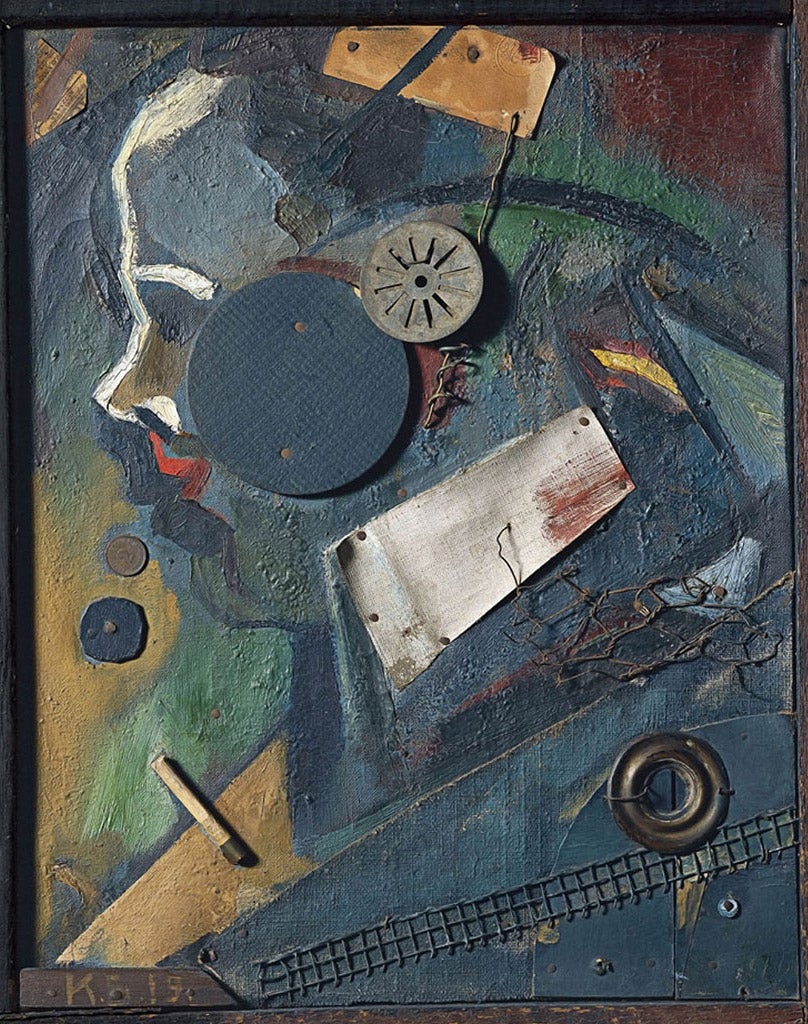Great Works: Merz Picture 1A (The alienist), 1919 (51.5cm x 41.3cm), Kurt Schwitters
Museo Thyssen-Bornemisza, Madrid

Your support helps us to tell the story
From reproductive rights to climate change to Big Tech, The Independent is on the ground when the story is developing. Whether it's investigating the financials of Elon Musk's pro-Trump PAC or producing our latest documentary, 'The A Word', which shines a light on the American women fighting for reproductive rights, we know how important it is to parse out the facts from the messaging.
At such a critical moment in US history, we need reporters on the ground. Your donation allows us to keep sending journalists to speak to both sides of the story.
The Independent is trusted by Americans across the entire political spectrum. And unlike many other quality news outlets, we choose not to lock Americans out of our reporting and analysis with paywalls. We believe quality journalism should be available to everyone, paid for by those who can afford it.
Your support makes all the difference.Kurt Schwitters first invented the term merz in 1919, to describe his own artistic practice. It began its life as a fragment of a word – it had clearly fallen off the back end of commerz, which means commerce in German. Schwitters opted for the fragment, and tacked it to other words, depending upon the nature of the game that he was playing with his art. This was what Schwitters was doing all the time, playing games with shapes, colours, bits of detritus. He did the same sort of thing when he made his wonderful sound poems, creating sound shapes in the air that had something to do with other kinds of sound shapes, but not too much.
So merz came to mean and to encapsulate everything that he did and was as a practising artist. This would have pleased him, this trajectory, speeding him from nowhere to everywhere, defining himself in this pell-mell, serendipitous way. He would have delighted in its boomy hollowness, in its lack of any meaning. This meant that he could fill it just as full of meaning – or leave it just as empty of meaning – as he liked. Anyway, what does the word meaning really mean when applied to art? Art is often not really about meanings that can be nailed to a board, and especially not abstract art. Abstract art is so thrillingly baggy and portmanteau-like precisely because it is thirsting for meaning to be poured into it by the onlooker. Meaning in art often shifts and drifts about – just as it does in poetry, and Schwitters was certainly a poet, if not the most experimental of poets.
To understand Schwitters and his artistic practice, it is a good idea to look at quite a lot of his work – there is a fine, recent book called Kurt Schwitters: Color and Collage, for example, edited by Isabel Schulz, which will give you a useful, nerve-jangling flight over this wild psychological terrain. Schwitters wanted his art to be seen as a total endeavour, the bombing of entire cultural neighbourhoods with merz and yet more merz. The work is full of a cranky, self-conscious humour. It is always calling attention to the fact that it is part of an ongoing engagement with art-making – which makes us question, of course, what exactly art-making is, has been, and is supposed to be. It poses all these questions all at once.
Here we have a collage picture made up of bits of this, that and the other – gathered, as Yeats once wrote in a great, late poem, from the foul rag-and-bone shop of the heart. It is a bit of painting (including a bit of a portrait in profile) and a bit of a sculpture. It is clearly, and perhaps most all, an art contrivance that looks as if it wants to be on the move somewhere – see how those two circles seem to grind together, like cogs in motion, and how that fragment of rising blue thread resembles the onrush of a railway track.
ABOUT THE ARTIST
Kurt Schwitters (1887-1948), a pioneer of installation art, was one of the great experimentalists of the 20th century. He coined the term merz to describe his total endeavour as an artist. He used found materials of the most humdrum kind in an idealistic attempt to forge an unbreakable bond between the idea of life as we live it and art as some practise it. The culmination of all this was his room-size, walk-in sculpture 'Merzbau' in Hanover, which was destroyed by the Nazis in 1943, and partially re-created from photographs in the early 1980s.
Join our commenting forum
Join thought-provoking conversations, follow other Independent readers and see their replies
Comments